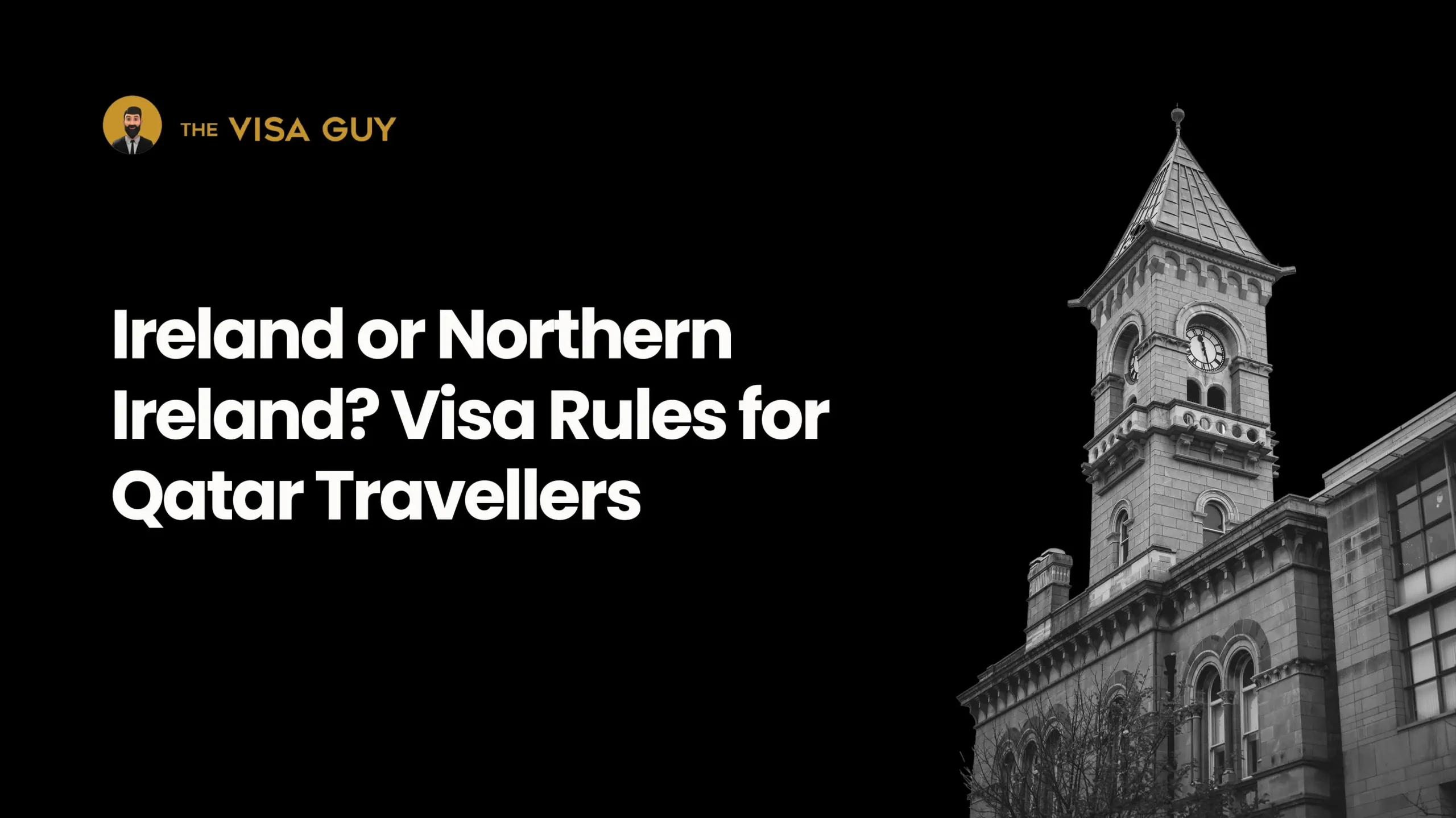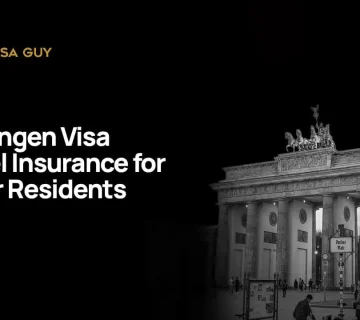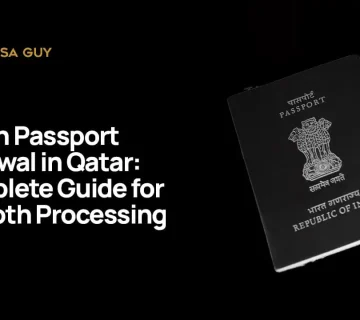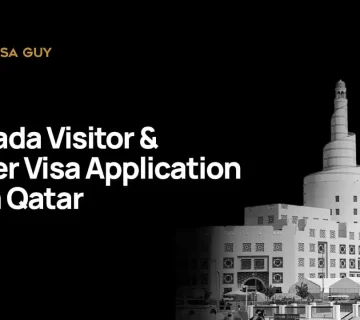Ireland vs Northern Ireland? Before setting your itinerary to visit Ireland, please take a moment with us.
You can’t visit both Ireland and Northern Ireland with a single visa.
Why is it so?
What else do you need to do to visit Ireland as a tourist?
The differences between Irish and Northern Irish visas.
The visa requirement is the same for both.
Get answers for all these questions and finally, listen carefully to the tips from visa experts in Qatar.
Shall we start our journey?
Why Do You Need Two Visas to Visit All of Ireland?
The reason is simple!
The island of Ireland is divided into two separate regions with different governments and immigration systems.
- The Republic of Ireland is an independent country with its own visa rules.
- Northern Ireland is part of the United Kingdom, which has a completely different visa system.
That means:
- A visa for the Republic of Ireland does not permit entry to Northern Ireland.
- A UK visa does not automatically allow you into the Republic of Ireland.
Even though there’s no physical border between the two regions, immigration rules still apply. So, if you plan to cross from one side to the other during your trip, you’ll likely need two separate visas, one for each region.
Always check visa requirements for both before you travel, so your journey across the Emerald Isle goes smoothly!
Contact our visa consultant in Qatar if you have any questions.
Different visas for two regions in the same country might make you wonder.
Want to know why it happened?
Let’s look at a bit of history this time!
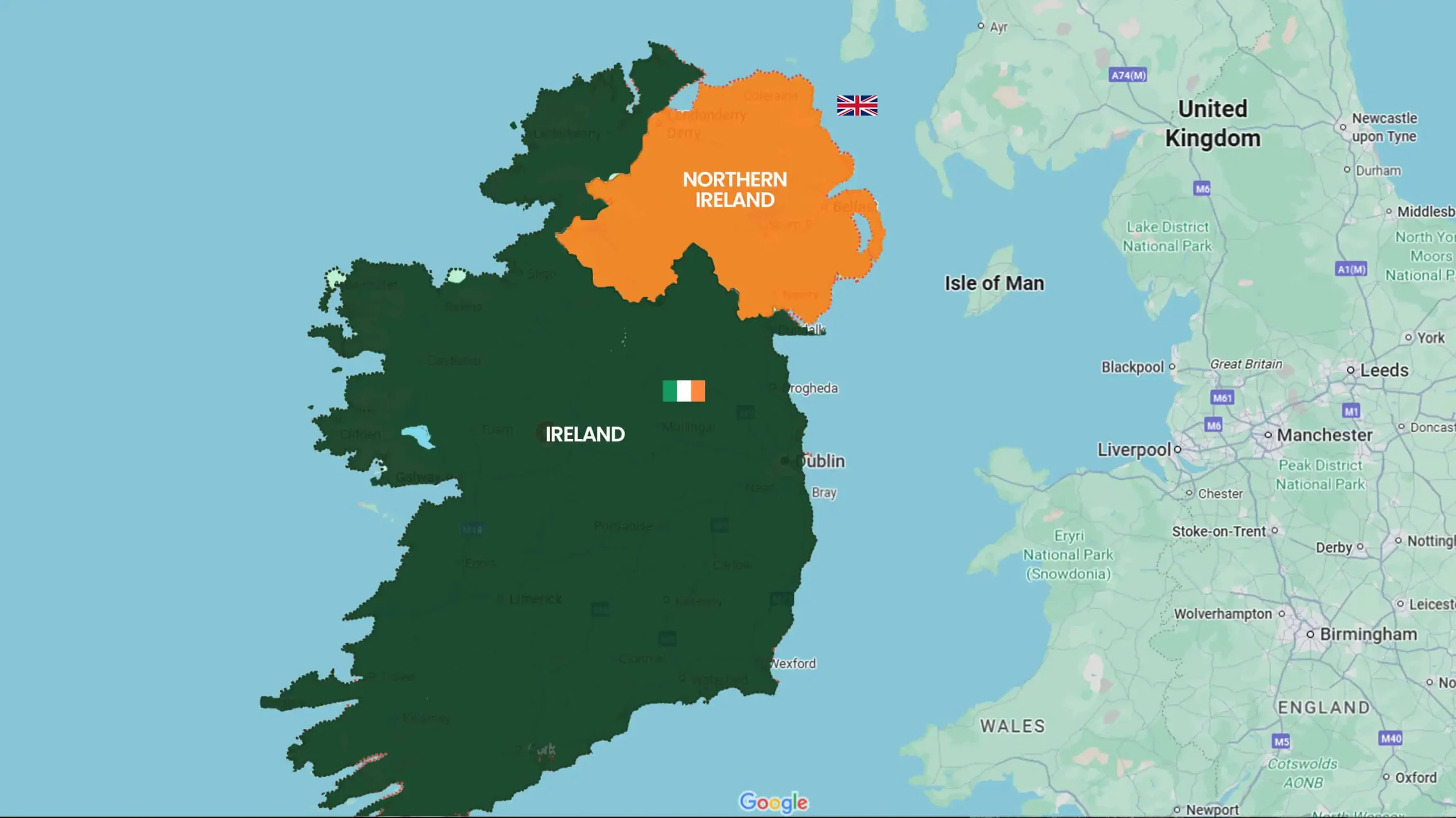
Why Two Visas? The Reason Behind the Separation
To understand why you might need two visas to visit all of Ireland, we need to look at a bit of history and how it shaped today’s visa rules.
Let’s condense the long history.
In 1922, most of Ireland gained independence from Britain and became what is now the Republic of Ireland.
However, Northern Ireland, located in the northeastern part of the island, chose to remain part of the United Kingdom.
Since then, both regions have developed separate governments, laws, and immigration systems.
That’s why traveling between the two isn’t as simple as crossing a city border; you’re technically crossing into a new country with different entry rules.
The Republic of Ireland has its own visa system. It’s not part of the Schengen Area, and it’s not part of the UK. You need a separate Irish visa to enter, unless you’re from a visa-exempt country.
Northern Ireland, as part of the UK, follows the United Kingdom’s visa rules. A UK visa allows entry to England, Scotland, Wales, and Northern Ireland, but not the Republic of Ireland.
So, even though both regions are on the same island, you can’t freely move between them unless you have the correct visa for each.
When our visa consultants explain this, the next question our travelers ask is:
“What about Schengen?’’
Neither the UK nor the Republic of Ireland is part of the Schengen Zone, which allows passport-free travel across many European countries.
So, a Schengen visa will not allow you entry into either part of Ireland.
But, there is one limited exception: the British Irish Visa Scheme (BIVS).
This scheme allows Indian and Chinese nationals to travel between the UK and Ireland on a single visa, only if they apply through the correct BIVS process.
For example:
A BIVS-endorsed UK visa allows Indian/Chinese nationals to enter the Republic of Ireland without a separate Irish visa.
A BIVS-endorsed Irish visa allows them to visit Northern Ireland as part of the UK.
Gentle Reminder: This only applies to nationals of India and China. If you are a traveler from another country, you must apply for two separate visas if you want to visit both regions.
There’s no physical border between Ireland and Northern Ireland, but you’ll still notice many important differences. It’s good to know them before you travel.
Ireland vs Northern Ireland: Know the Difference
What tourists notice first when visiting Ireland and Northern Ireland is the difference in road signs. Although the land and terrain look almost the same, the signs are different.
In the UK (including Northern Ireland), road signs are written only in English. In the Republic of Ireland, the road signs are bilingual; they show both Irish and English.
English place names appear in capital letters, while Irish names are written in a slanted style, similar to italics.
Don’t think that’s the only difference!
Here is a list curated just for you!
Difference Between Ireland and Northern Ireland
| Feature | Republic of Ireland | Northern Ireland |
| Capital | Dublin | Belfast |
| Belongs to | Independent country | Part of the United Kingdom |
| Visa Requirement (Qatar) | Need an Irish visa | Need a UK visa |
| Schengen Area | No | No |
| Currency | Euro (€) | British Pound (£) |
| Entry Restrictions | Follow Irish immigration rules | Follow UK immigration rules |
| Flight Routes from Qatar | Direct flights to Dublin (sometimes via stops) | Flights connect through UK cities (like London) |
| Flight Entry Points | Dublin Airport | Belfast International Airport or airports in the UK |
| Languages Spoken | English and Irish (Gaelic) | English |
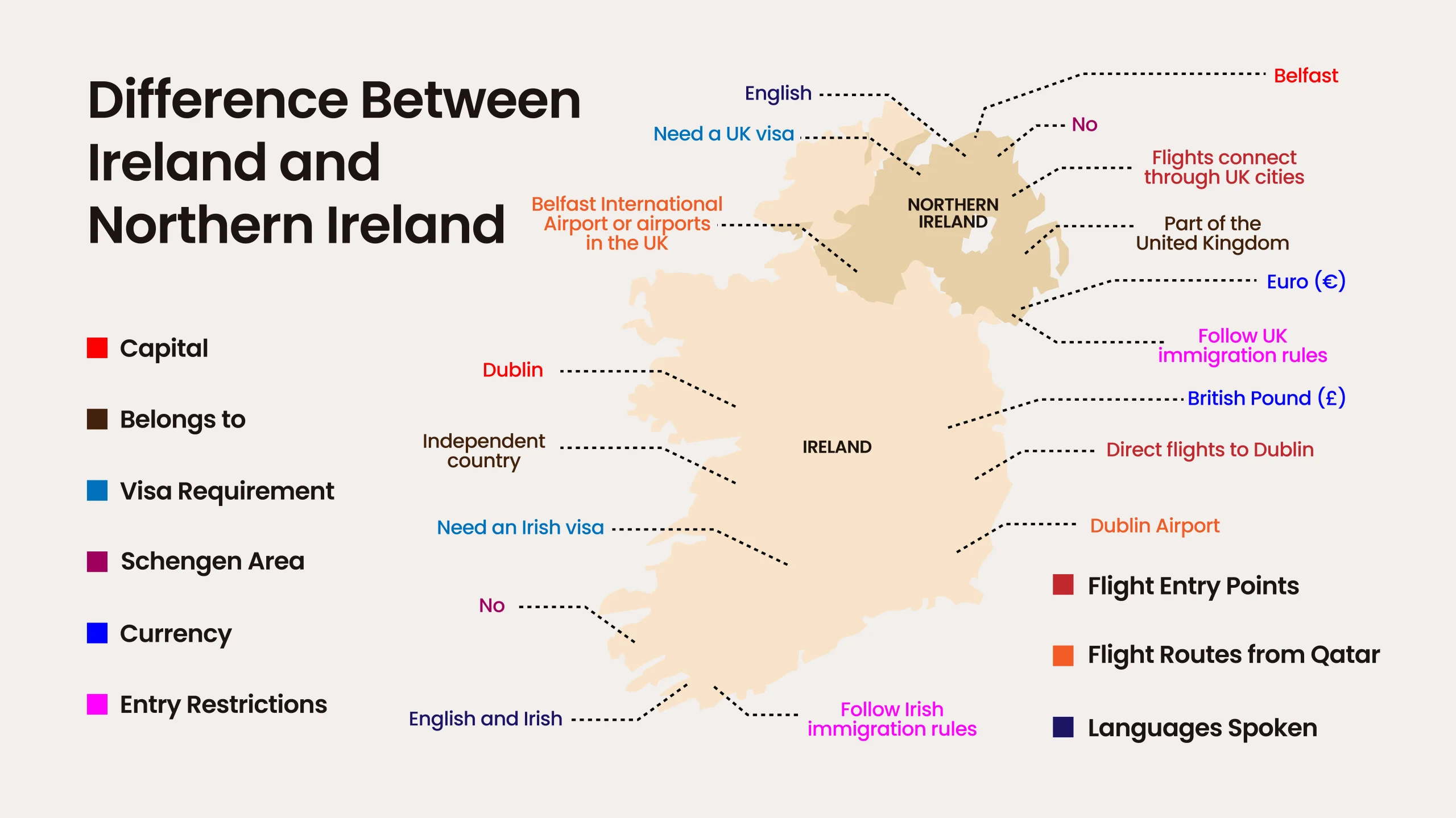
Let’s move to the core part of the topic: the visa eligibility criteria.
Visa Types & Requirements for the Republic of Ireland (South)
-
Visa Types:
If you plan to visit or stay in the Republic of Ireland, the type of visa you need depends on how long you intend to stay. Visas are mainly divided into two categories:
- Short-Stay (Type C)
- Long-Stay (Type D).
| Short Stay (Type C) | Long-Stay (Type D) |
|
|
Documents Needed for an Ireland Visit Visa
- Passport
Provide your original passport (valid for 6+ months after your trip) and copies of previous visas or stamps. - Visa Application Form
Fill out the online form, then print, sign, and date the summary sheet. - Passport Photos
Attach 2 recent passport-size color photos (35 × 45 mm). Write your name and application number on the back. - Cover Letter
Write a short letter explaining why you’re visiting, how long you’ll stay, where you’ll stay, and who’s paying. - Accommodation Proof
Share hotel bookings or, if staying with someone, include their invitation letter and proof of their address. - Travel Itinerary
List your travel plans like where you’ll go, what you’ll do, and how long you’ll stay. - Financial Proof
Show the recent 6 months of bank statements and payslips. If someone else is paying, include their financial documents too. - Visa Fee Receipt
Add proof you paid the visa fee (or proof you’re exempt). - Previous Visa Refusals
If any visa was refused earlier, include a copy of the refusal letter or reason. - Proof of Legal Residence (if needed)
If you’re applying from a country that’s not your home country, include your valid residence permit. - Travel Insurance
Not needed when applying, but required on arrival. It must cover €30,000 for emergencies and medical care.
- Extra Documents (if applicable)
- For students: school acceptance, ID card, or fee payment.
- For workers: a job letter or a business registration.
- For family visits: birth or marriage certificates to show your relationship.
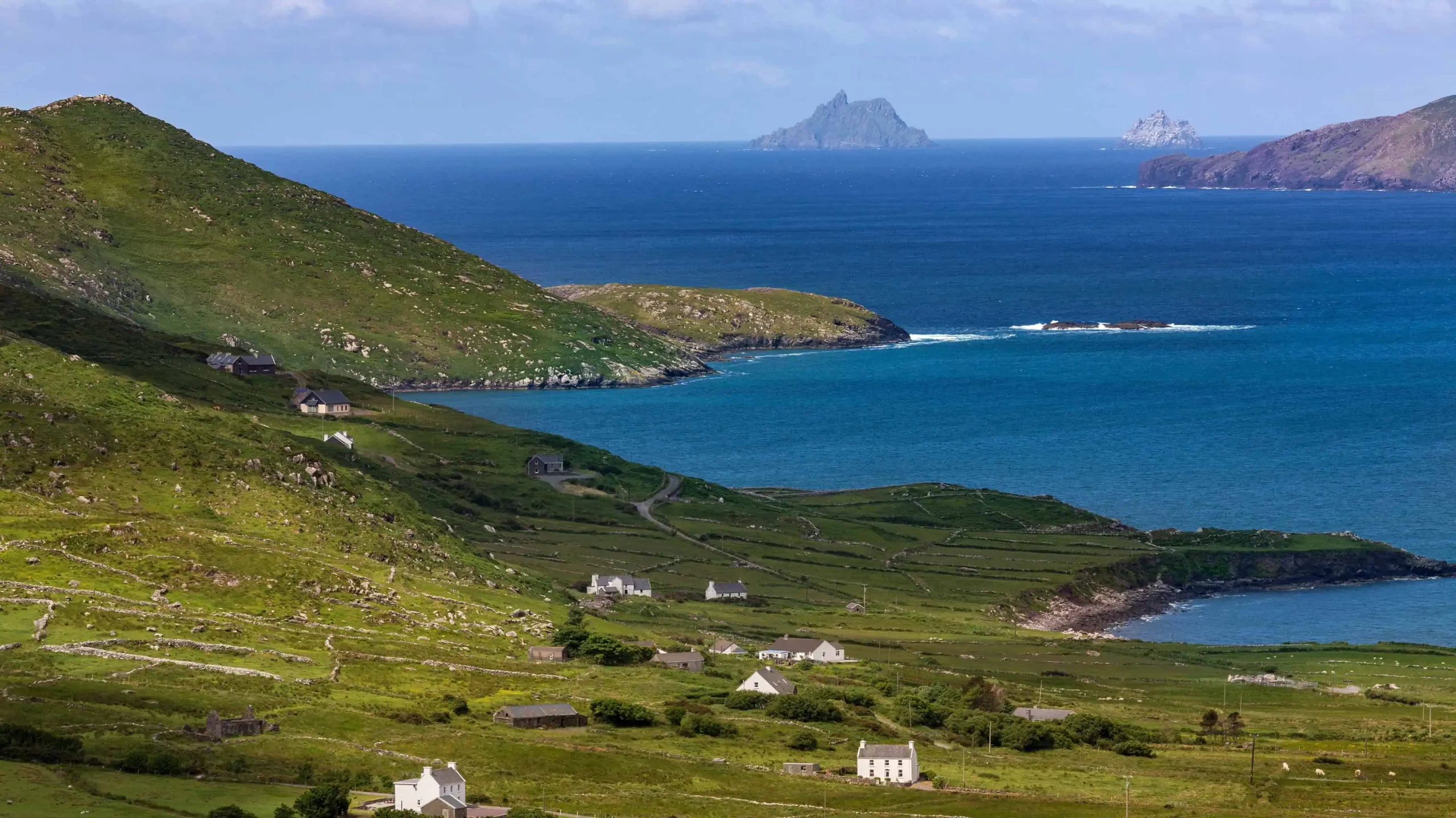
How to Apply for an Irish Visa
- Fill Out the Online Form:
Start by completing the visa application form on the Immigration Service Delivery website. Once you finish, you’ll get a summary sheet. - Prepare Your Documents:
Collect all required documents, such as your passport, passport photos, and proof of funds to show you can cover your trip expenses. - Submit Your Application:
Submit the application form, the summary sheet, and your supporting documents to the Visa Application Centre. You may also have to provide biometric data (fingerprints and photo). - Processing Time:
A Short-Stay visa usually takes up to 8 weeks from the date your documents reach the visa office. Apply early to avoid delays.
Visa Requirements for Northern Ireland (UK)
Visa Types:
If you’re planning to travel to Northern Ireland, which is part of the United Kingdom, the visa you need will depend on your nationality.
Most travelers will either need a Standard Visitor Visa or an Electronic Travel Authorisation (ETA).
A Standard Visitor visa lets you visit Northern Ireland for tourism, business, or short-term study (up to 6 months). If you’re going for a different reason, like to work, study for a longer time, or join a family, you’ll need a different type of UK visa that matches your purpose.
Starting from April 1, 2025, citizens of some countries. Including many from the EU, will need an ETA to enter the UK, including Northern Ireland.
The ETA is a quick online approval and not a full visa, but it’s still required before travel.
If you want to visit both the Republic of Ireland and Northern Ireland, and you’re from a country that requires a visa, you’ll probably need two visas: a UK visa for Northern Ireland and a multiple-entry Irish visa for the Republic of Ireland.
Always check the latest entry rules before you travel to avoid any issues.
In order to apply for an Ireland visa, follow the exact steps we provided below.
Remember, visa rules might change from time to time, so consult our visa experts for updated information and guidance on Ireland visa requirements.

Documents Needed For a UK Visa:
- Valid Passport
Use your original passport with at least one blank page. It must be valid for the full length of your trip. - Visa Application Form
Fill out the online form on the UK Visas and Immigration (UKVI) website. Submit and print the confirmation page. - Passport-Size Photo (if required)
Some applicants may need to bring a recent passport-size photo. Follow UK photo guidelines. - Proof of Finances
Show bank statements for the last 6 months to prove you can pay for your trip and stay in the UK. - Accommodation Details
Provide hotel bookings or a letter from the person you will stay with, including their address. - Travel Plan (Itinerary)
Write a simple plan of where you’ll go, what you’ll do, and how long you’ll stay. - Employment or Study Letter
1. If employed: include a letter from your employer confirming your job and
leave.
2. If self-employed: show business registration and income proof.
3. If a student: provide a letter from your school or university. - Invitation Letter (if visiting someone)
Ask your host in the UK to write a letter with their address, contact info, and how they’ll support your visit. - Proof of Relationship (for family visits)
Include birth, marriage, or other certificates to prove your relationship with the person you’re visiting. - Travel History
Add copies of previous visas and entry/exit stamps from your passport. - Visa Fee Payment
Pay the visa fee online and keep the confirmation receipt.
If you are planning to visit Northern Ireland, UK, as a tourist, you’ll need to apply for a UK visa from Qatar. Here’s how you can get started with the process.
How to Apply for a Northern Irish Visa (UK Visa)
- Check If You Need a Visa:
Look at the official UK website to see if your nationality requires a UK visa to enter Northern Ireland. - Apply Online:
If you do, complete the UK visa application form online on the official government website. - Submit Your Documents:
Provide your passport, photos, and any other required documents at the UK Visa Application Centre. - Processing Time:
Processing times vary, so always check the UK Visas and Immigration website for current timelines.
It’s important to understand the visa process thoroughly. Check out our detailed guide on common UK visa rejection reasons for step-by-step insights and expert tips to avoid mistakes.
When & How to Apply – Timeline Tips for Qatar Residents
If you live in Qatar and plan to visit Ireland or Northern Ireland, apply for your visa well in advance. It’s best to apply at least 6–8 weeks before your travel date to avoid delays. Visa processing times may vary, especially during busy seasons or holidays.
Double-check which country you’re visiting:
- Republic of Ireland → Irish visa
- Northern Ireland (part of the UK) → UK visa
- Use a checklist to make sure you don’t miss any documents.
- Translate documents into English if they are in another language.
- Avoid last-minute flight bookings until your visa is approved.
- Book appointments early, especially during peak travel times.
- Keep photocopies of everything you submit, including your passport pages.
- Check the embassy/VFS holidays to avoid delays.
- Use express courier return services if you need your passport back urgently.
- Stay updated by checking your email and tracking portal regularly.
If you want to travel often, a UK multiple-entry visa is a great choice. It allows you to visit the UK multiple times without reapplying.
To avoid delays, it’s important to apply carefully and avoid common mistakes. You can also check out the common reasons for UK visa denials and how to avoid them to improve your chances of approval.
FAQ
Can a Schengen Visa Help to Enter Ireland or the UK?
No, a Schengen visa does not allow you to enter Ireland or the UK. Both Ireland and the UK have their own visa systems and are not part of the Schengen Area. You need to apply for a separate visa for each country.
How Long Does It Take to Get Each Visa?
For an Irish visa, the processing time for a short-stay visa is usually up to 8 weeks after the application reaches the visa office.
For a UK visa (including Northern Ireland), it normally takes about 3 to 6 weeks, but it can vary depending on the time of year and your application type. It’s best to apply at least 3 months before your trip.
Do I Need Both UK and Ireland Visas If I Want to Visit Dublin and Belfast?
Yes, in most cases you need two separate visas. An Irish visa is required to visit Dublin, and a UK visa is required to visit Belfast because Northern Ireland is part of the UK. The only exception is for Indian and Chinese nationals under the British Irish Visa Scheme (BIVS), which allows travel between the two on a single visa.
Is Northern Ireland in Schengen?
No, Northern Ireland is not part of the Schengen Area. If you want to learn which countries are in Schengen and how it works, check out this Schengen countries travel guide.

